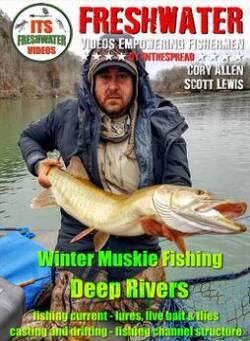Open water muskie fishing appears daunting without visible structure, but fish position predictably at underwater geo intersect points. Cory Allen explains the X and Y axis method for breaking down topographical features, understanding when muskies suspend versus relate to bottom contours, and selecting presentations that intercept fish in seemingly featureless water.
Muskie Fishing Open Water with Cory Allen
(00:33:36)Muskie Fishing in Open Water: Topography and Positioning Strategies
Open water muskie fishing intimidates most anglers because the absence of obvious structure like weed edges, docks, or visible rock piles creates uncertainty about where fish position and how to present lures effectively. Cory Allen demonstrates why open water isn't actually structure-free but rather requires understanding underwater topography and the "X and Y axis" approach that identifies geo intersect points where muskies concentrate despite appearing to be suspended randomly in featureless basins. Mastering this largely unexplored aspect of muskie angling expands your productive water dramatically beyond the shoreline structure most anglers compete to fish.
Why Do Muskies Position Predictably in Seemingly Featureless Open Water?
Open water muskies relate to underwater topographical features including depth changes, bottom composition transitions, and current flows that aren't visible from the surface but concentrate forage and create ambush opportunities. These fish aren't aimlessly floating but positioning at specific geo intersect points where multiple environmental factors converge. Understanding that "open water" means absence of visible structure rather than complete lack of fish-holding features changes how you approach these areas. Cory Allen's X and Y axis method breaks down horizontal and vertical positioning factors that determine where muskies hold in water appearing uniform from the surface.
How Do You Identify Productive Topographical Features in Open Water?
Electronics reveal underwater contours, depth changes, and bottom composition variations that position muskies in open water. Reading these features requires interpreting how subtle depth changes, points extending into basins, and saddles between underwater humps create the structure muskies use despite being submerged and invisible. The skill involves translating two-dimensional sonar information into three-dimensional understanding of how fish relate to underwater topography.
When Do Muskies Suspend Versus Relating to Bottom Structure?
Suspended muskies following baitfish schools in mid-water column require different presentation approaches than fish holding tight to bottom contours. Understanding what triggers suspension versus bottom orientation helps you select appropriate lures and depths. Water temperature, available forage, and time of year all influence whether muskies position vertically in the water column or relate horizontally to bottom features.
User Reviews
Cory Allen
Cory Allen, known as the Tennessee Muskie Authority, has years of expertise in muskie fishing. He is a skilled guide in the Tennessee River drainage basin, specializing in understanding muskellunge behavior and environmental conditions. Allen's dedication to his craft and continuous learning make him a valuable resource for both seasoned and novice anglers.
Read more



